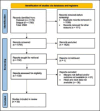Margins in head and neck non-melanoma skin cancer surgery: clinical/pathological criteria and their impact on oncological outcomes and therapeutic choices. A systematic review
- PMID: 40400382
- PMCID: PMC12115412
- DOI: 10.14639/0392-100X-suppl.1-45-2025-N1121
Margins in head and neck non-melanoma skin cancer surgery: clinical/pathological criteria and their impact on oncological outcomes and therapeutic choices. A systematic review
Abstract
Introduction: Non-melanoma skin cancers (NMSCs), including basal (BCC) and squamous cell carcinoma (SCC), are the most prevalent malignancies affecting the skin, with the head and neck region being the most common site of involvement. Surgical excision remains the primary treatment modality. The role of surgical margins in the treatment of skin SCC and BCC of the head and neck remains a subject of ongoing debate. Clear definitions and guidelines regarding adequate surgical margins, as well as their impact on recurrence rates and overall outcomes, are critical for improving clinical management. This systematic review aims to evaluate the current literature on the definitions of surgical margins for SCC and BCC of the head and neck, as well as their impact on local recurrence, disease free survival, and other patient-centred outcomes.
Materials and methods: We conducted a systematic review following the PRISMA guidelines. A comprehensive search was performed across multiple databases, including PubMed and Scopus, for studies published up to December 2024. Eligible studies included those that reported on surgical margin definitions, surgical outcomes, and recurrence rates for SCC and BCC of the skin in the head and neck region. Data were extracted and analysed for margin size and oncological outcomes.
Results: Following the application of inclusion and exclusion criteria, 30 studies have been retrieved for qualitative synthesis. Of these, 12 studies focused on SCC only, 14 on BCC only, and 4 on mixed histologies. Margin involvement rates ranged widely across the studies included (5-56%) as did thelocal recurrence rate (0-20%). This is associated with a variability of the surgical margin both for SCC and BCC, and of the definition of margin as close/negative at final pathology. Most studies do not define a threshold for close vs. negative margins at final pathology. All studies but one reported a significant correlation between positive margins and oncological outcomes, with particular regards to local recurrence.
Conclusions: The findings highlight a lack of consensus on the optimal surgical margins for SCC and BCC of the head and neck, suggesting that margins may need to be individualised based on tumour characteristics, location, and patient factors. In particular, the anatomical complexity of the head and neck region suggests to separately address different high-risk areas as nose/midface, periauricular, and periocular with specific recommendations also concerning clinical margins.
Keywords: BCC; SCC; head and neck; non melanoma skin cancer; resection margins.
Copyright © 2025 Società Italiana di Otorinolaringoiatria e Chirurgia Cervico-Facciale, Rome, Italy.
Conflict of interest statement
The authors declare no conflict of interest.
Figures




Similar articles
-
Head and neck cutaneous basal cell carcinoma: a retrospective analysis of tumour features, surgical margins and recurrences.Eur Arch Otorhinolaryngol. 2025 Jun;282(6):3183-3191. doi: 10.1007/s00405-025-09216-z. Epub 2025 Feb 20. Eur Arch Otorhinolaryngol. 2025. PMID: 39979627 Free PMC article.
-
Non-melanoma skin cancer: United Kingdom National Multidisciplinary Guidelines.J Laryngol Otol. 2016 May;130(S2):S125-S132. doi: 10.1017/S0022215116000554. J Laryngol Otol. 2016. PMID: 27841126 Free PMC article.
-
Efficacy of curettage before excision in clearing surgical margins of nonmelanoma skin cancer.Arch Dermatol. 2000 Nov;136(11):1327-32. doi: 10.1001/archderm.136.11.1327. Arch Dermatol. 2000. PMID: 11074693
-
Surgical management of non melanoma skin cancer of the head and neck.Oral Oncol. 2020 Jan;100:104485. doi: 10.1016/j.oraloncology.2019.104485. Epub 2019 Dec 9. Oral Oncol. 2020. PMID: 31821988 Review.
-
Margins in major salivary gland surgery: clinical and pathological criteria for defining margins and their implications on the choice of multimodal therapies. A systematic review.Acta Otorhinolaryngol Ital. 2025 May;45(Suppl. 1):S109-S120. doi: 10.14639/0392-100X-suppl.1-45-2025-N1108. Acta Otorhinolaryngol Ital. 2025. PMID: 40400381 Free PMC article.
References
-
- Rogers HW, Weinstock MA, Feldman SR, et al. . Incidence estimate of nonmelanoma skin cancer (keratinocyte carcinomas) in the U.S. population, 2012. JAMA Dermatol 2015;151:1081-1086. https://doi.org/10.1001/jamadermatol.2015.1187 10.1001/jamadermatol.2015.1187 - DOI - PubMed
-
- Aggarwal P, Knabel P, Fleischer AB, Jr. United States burden of melanoma and non-melanoma skin cancer from 1990 to 2019. J Am Acad Dermatol 2021;85:388-395. https://doi.org/10.1016/j.jaad.2021.03.109 10.1016/j.jaad.2021.03.109 - DOI - PubMed
-
- Global Burden of Disease Cancer Collaboration et al. Global, regional, and national cancer incidence, mortality, years of life lost, years lived with disability, and disability-adjusted life-years for 29 cancer groups, 1990 to 2017: a systematic analysis for the Global Burden of Disease study. JAMA Oncol 2019;5:1749-1768. https://doi.org/10.1001/jamaoncol.2019.2996 10.1001/jamaoncol.2019.2996 - DOI - PMC - PubMed
-
- Quazi SJ, Aslam N, Saleem H, et al. . Surgical margin of excision in basal cell carcinoma: a systematic review of literature. Cureus 2020;12:E9211. https://doi.org/10.7759/cureus.9211 10.7759/cureus.9211 - DOI - PMC - PubMed
-
- Wolf DJ, Zitelli JA. Surgical margins for basal cell carcinoma. Arch Dermatol 1987;123:340-344. - PubMed
Publication types
MeSH terms
LinkOut - more resources
Full Text Sources
Medical
Research Materials

